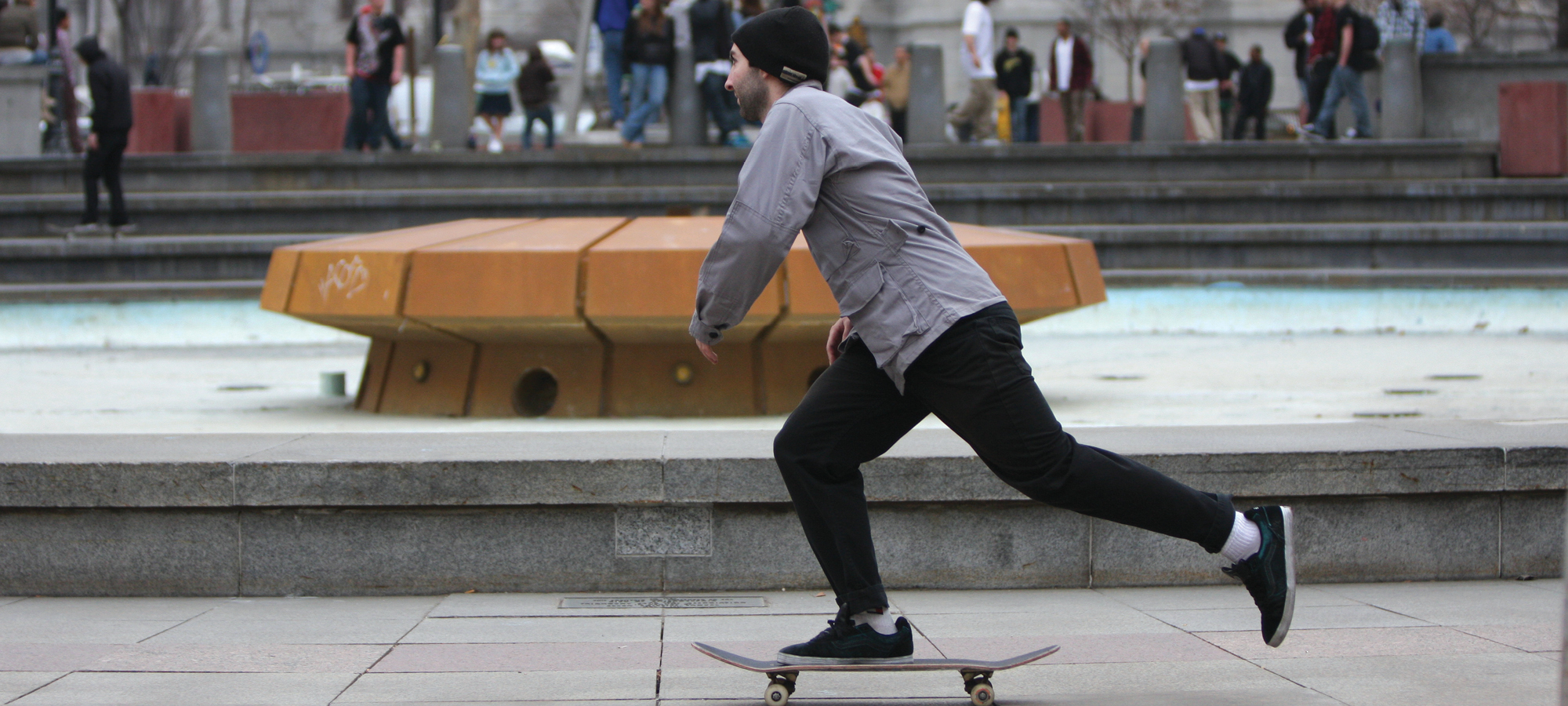
Despite a city ban, skaters flocked to LOVE Park for decades. (Photography by Melody Joy Kramer [CC BY-NC-ND 2.0])
What the fight over an iconic Philadelphia skate spot means for cities everywhere.
In the late 1980s, a group of skateboarders discovered an underused square in downtown Philadelphia and made it their own. To them, John F. Kennedy Plaza (known to most as LOVE Park, thanks to Robert Indiana’s iconic sculpture) was a granite paradise. Before long, professionals and amateurs from around the world began making pilgrimages there.
But Philadelphia’s leaders took a dim view of the park. It had become a hangout for drug dealers and the homeless, alongside skaters. In 2012, the city announced plans for a major redevelopment, sparking a debate that lingers even today. Skaters and supporters felt the community they’d created at LOVE Park was a distinctive, authentic Philadelphia treasure.
In the fight over LOVE Park’s future, PhD student Luke Cianciotto, AM’18, saw a distillation of what he’d been studying in urban sociology—and what he’d experienced as a skateboarder. Here were two groups, the city and the skateboarders, each asserting a different type of ownership over a public space. These fraught claims were the subject of Cianciotto’s master’s thesis, which became an article in the journal City & Community.
Often, conflicts over urban property center on the privatization of public land. Yet this public-private binary “leaves a lot out,” Cianciotto says. The dispute over LOVE Park was just as complex as any dispute over a private space. But his field didn’t have a good way to talk about it. So he proposed a new framework, arguing for a conceptual distinction between public space—which is designed, managed, and surveilled—and common space—which is flexible, spontaneous, and self-managed by its users.
Both public and common spaces can be putatively open to all, but users experience them very differently. The boundary between public and common is porous, as when a spontaneous neighborhood block party spills out into a city street.
The distinction between public and common space is “a brilliant distinction and a very useful one,” says Marco Garrido, an assistant professor of sociology and Cianciotto’s adviser. “We’re seeing a trend … of spaces being sanitized and becoming increasingly anti-common, despite their publicness”—think, he says, of Chicago’s Millennium Park. The advent of so-called hostile architecture, designed to discourage loitering, sleeping, and skateboarding, troubles critics who feel such measures are not only unnecessary but also unfair. Public spaces, they argue, should not discourage public use.
One perhaps surprising proponent of that view was the John F. Kennedy Plaza architect, Edmund Bacon, who in 2002, at the age of 92, rode a skateboard across the park to protest the city’s skateboarding ban. “Skateboarding at JFK is wonderful,” he said. “It does no harm to anyone.”
Central to the skateboarding community’s claim over LOVE Park was sweat equity: they took care of the space, even removing snow in winter. As one former LOVE Park skater told Cianciotto, “We really considered it ours. … I don’t know of any other citizen who would just willingly shovel a city property for free.”
But this wasn’t the type of community or caretaking that the city valued. The old LOVE Park didn’t fit their vision for a rebranded downtown. “It was a beacon of deviance set right across from city hall,” Cianciotto says.
Rather than intense use by a small, devoted group, city leaders imagined casual use by a broader public. They proposed a more tourist-friendly offering, with a beer garden, food trucks, concerts, and cafés. It was, Cianciotto feels, not only a shift from commonness to publicness, but also a transformation of the irreplaceable into the banal.
To Cianciotto, this debate—intense use and caretaking by a dedicated group versus more circumscribed use by a broader public—is a hallmark of the public/common dilemma. He’s particularly interested in homelessness in public spaces, which raises many of the same questions as skateboarding in LOVE Park: Who do we include and exclude from the category of “the public”? What makes one type of use more valid than another?
He’s currently researching a longstanding tent city in Chicago’s Uptown neighborhood, near the entrance to a city-sanctioned skate park he visits often. His interest in sociology continues to intersect with—and traces back to—his own skateboarding. After years spent scouting for skateable features and surfaces, skaters develop “a unique sensitivity to space,” he says. “Skateboarding really shapes the way you think and look at the world around you.”
And he’s continuing to watch how LOVE Park evolves. The rebranded plaza is working much as city planners envisioned it, with downtown workers eating lunch and tourists taking photos with the LOVE sculpture. But the old LOVE Park hasn’t been fully erased: enforcement is much stronger now, but the occasional skater still pushes along, undaunted.
